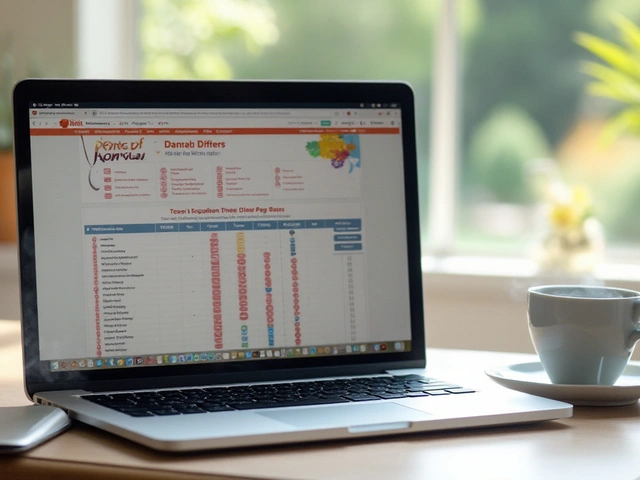Type 2 Diabetes Medication Comparison Tool
This tool helps you evaluate diabetes medication options based on your specific health characteristics and preferences. Enter your key parameters to see which drugs might be most appropriate for your situation.
When treating type 2 diabetes, Metformin is a biguanide oral medication that lowers blood sugar by reducing liver glucose production and improving insulin sensitivity. It’s the first drug most clinicians prescribe, but a growing list of newer agents offers different benefits and trade‑offs. If you’ve ever wondered whether Metformin vs alternatives makes sense for you, this guide breaks down the science, the numbers, and the real‑world experience behind each option.
Why Metformin Became the Benchmark
Metformin earned its spot by delivering solid HbA1c reductions (about 1‑1.5%) with a low cost and a modest side‑effect profile. The UKPDS (United Kingdom Prospective Diabetes Study) showed a 39% lower risk of diabetes‑related complications for patients on Metformin, cementing its reputation as a safe, weight‑neutral choice. Its safety record spans decades, and it’s approved worldwide, from the FDA in the United States to the EMA in Europe.
Core Alternatives to Consider
Newer drug classes target different pathways in glucose regulation. Below is a quick snapshot of each major group.
- Sulfonylureas: stimulate pancreatic insulin release.
- GLP‑1 receptor agonists: mimic the incretin hormone GLP‑1 to boost insulin and slow gastric emptying.
- SGLT2 inhibitors: block glucose re‑absorption in the kidneys, causing sugar to be expelled in urine.
- DPP‑4 inhibitors: prevent breakdown of incretin hormones, modestly increasing insulin.
- Thiazolidinediones (TZDs): improve peripheral insulin sensitivity.
- Insulin therapy: replaces or supplements endogenous insulin.
Mechanism‑by‑Mechanism Comparison
| Drug Class | Primary Mechanism | Typical Dose Range | HbA1c Reduction | Weight Effect | Common Side Effects | Average Monthly Cost (USD) |
|---|---|---|---|---|---|---|
| Metformin | Decreases hepatic gluconeogenesis | 500‑2000 mg daily | 1‑1.5 % | Weight‑neutral or slight loss | GI upset, rare lactic acidosis | ~$4‑$10 |
| Sulfonylureas | Stimulate pancreatic β‑cells | 2.5‑10 mg daily (glipizide) | 0.8‑1.5 % | Often weight gain | Hypoglycemia, dizziness | ~$5‑$12 |
| GLP‑1 receptor agonists | Enhance glucose‑dependent insulin secretion, slow gastric emptying | Weekly injection (0.5‑1 mg semaglutide) | 1‑1.8 % | Weight loss (2‑5 kg) | Nausea, vomiting, pancreatitis risk | ~$800‑$1200 |
| SGLT2 inhibitors | Block renal glucose re‑absorption | 10‑25 mg daily (empagliflozin) | 0.5‑1 % | Modest loss or neutral | UTI, genital infections, dehydration | ~$250‑$350 |
| DPP‑4 inhibitors | Prolong incretin activity | 5‑100 mg daily (linagliptin) | 0.5‑0.8 % | Weight‑neutral | Nasopharyngitis, slight risk of pancreatitis | ~$150‑$250 |
| Thiazolidinediones | Activate PPAR‑γ to improve insulin sensitivity | 15‑45 mg daily (pioglitazone) | 0.5‑1.2 % | Weight gain, fluid retention | Edema, heart‑failure risk, bone fractures | ~$30‑$80 |
| Insulin therapy | Replace or supplement endogenous insulin | Variable; basal 10‑40 U daily | 2‑3 %+ (depends on regimen) | Weight gain common | Hypoglycemia, injection site reactions | ~$150‑$300 |
When to Stick With Metformin
Metformin remains the go‑to for most newly diagnosed patients unless contraindicated. Its benefits shine when you need a drug that:
- Works well with a modest budget.
- Doesn’t cause weight gain.
- Has decades of safety data.
- Can be combined safely with almost any other oral agent.
Kidney function is the main red flag. If eGFR drops below 30 mL/min, most clinicians either halve the dose or stop the drug entirely.

Scenarios That Favor an Alternative
Real‑world practice shows several cues that push clinicians toward other classes:
- Significant weight gain on Metformin alone or with sulfonylureas - GLP‑1 agonists or SGLT2 inhibitors are often added for their weight‑loss effect.
- Inadequate HbA1c drop after 3‑6 months - adding a DPP‑4 inhibitor or switching to a thiazolidinedione may help.
- High risk of cardiovascular disease - SGLT2 inhibitors (e.g., empagliflozin) and some GLP‑1 agents have proven heart‑protective outcomes in large trials.
- Kidney impairment (eGFR 30‑45) - low‑dose SGLT2 inhibitors or dose‑adjusted Metformin are options, while sulfonylureas may need caution.
- Pregnancy planning - Metformin is sometimes continued, but insulin is the safest choice for tight control.
Side‑Effect Deep Dive
Understanding the nature of side effects helps you weigh trade‑offs.
Metformin mainly hits the gut. Up to 30% experience nausea, diarrhea, or abdominal cramping, especially when starting at a high dose. A slow titration schedule (e.g., 500 mg with dinner, then 500 mg with breakfast) cuts the problem dramatically.
Sulfonylureas carry the highest hypoglycemia risk, especially in elderly patients or those with irregular meals. If you’re prone to low blood sugar, a newer agent is safer.
GLP‑1 receptor agonists give you nausea and occasional vomiting, but most people feel better after the first two weeks. The injection route can be a barrier, though once‑weekly pens are now common.
SGLT2 inhibitors raise the chance of urinary‑tract and genital infections. Staying hydrated and practicing good hygiene mitigates most cases.
DPP‑4 inhibitors are the quietest class - they rarely cause weight change or hypoglycemia (unless combined with a sulfonylurea).
Thiazolidinediones may cause fluid retention, so they’re avoided in heart‑failure patients.
Insulin is the most potent, but the hypoglycemia risk is real. Using a basal‑bolus regimen with modern pens and CGM (continuous glucose monitoring) reduces episodes.
Cost Considerations in 2025
Prescription costs have shifted with new generics and insurance formularies. Metformin stays under $10 a month for most U.S. plans, while newer GLP‑1 agents remain premium ($800‑$1200). SGLT2 inhibitors have seen price drops after patent expiries, hovering around $250‑$350. If you’re paying out‑of‑pocket, a generic sulfonylurea or thiazolidinedione can be a decent back‑up, but remember the trade‑offs.

Putting It All Together - A Decision Checklist
- Check kidney function (eGFR). If <30, Metformin may be off‑label.
- Assess weight goals. Want to lose weight? Lean toward GLP‑1 or SGLT2.
- Review cardiovascular risk. Proven heart benefit: SGLT2 or certain GLP‑1 agents.
- Consider hypoglycemia tolerance. If low tolerance, avoid sulfonylureas.
- Calculate out‑of‑pocket cost. Generic Metformin or sulfonylureas are cheapest.
- Factor in administration preference. Oral vs injection vs weekly pen.
Run this checklist with your clinician and you’ll land on a regimen that matches your health profile, budget, and lifestyle.
Frequently Asked Questions
Can I take Metformin if I have kidney disease?
Metformin is safe down to an eGFR of about 30 mL/min. Below that, doctors usually halve the dose or stop it because the risk of lactic acidosis rises.
Do GLP‑1 agonists cause weight loss?
Yes. Most patients lose 2‑5 kg in the first six months, mainly because the drugs slow stomach emptying and curb appetite.
Why does Metformin cause stomach upset?
It irritates the GI lining, especially at higher doses. Starting low (500 mg) and using the extended‑release formulation cuts the side effects by about half.
Are SGLT2 inhibitors safe for people without diabetes?
They’re now approved for heart‑failure and chronic kidney disease even without diabetes, but they still increase infection risk, so doctors weigh benefits carefully.
When should I switch from Metformin to insulin?
If HbA1c stays above 9% despite the maximum tolerated Metformin dose plus a second oral agent, or if you develop severe insulin deficiency, insulin becomes the next step.
Bottom Line
Metformin still offers the best value‑for‑money, especially for patients who need a weight‑neutral, low‑cost starter. Newer agents fill niche gaps-heart protection, weight loss, and kidney safety-but they come with higher price tags and specific side‑effect profiles. Use the comparison table, the checklist, and the FAQ as a roadmap, then talk to your healthcare provider about the mix that fits your numbers and your life.






Vijaypal Yadav
20 October, 2025 . 20:26 PM
Metformin's primary advantage lies in its hepatic glucose suppression, which has been consistently demonstrated across multiple trials. The UKPDS data you cited still hold up, showing a clear reduction in macrovascular events when combined with lifestyle changes. In patients with eGFR above 45, a dose reduction to 500 mg twice daily often mitigates gastrointestinal upset without sacrificing efficacy. Moreover, its cost‑effectiveness is unmatched, especially in health systems with limited formularies. While newer agents offer niche benefits, the risk‑benefit profile of metformin remains the benchmark for first‑line therapy.
Ron Lanham
27 October, 2025 . 07:00 AM
It is ethically indefensible to prescribe pricey GLP‑1 analogues to patients who cannot afford basic necessities, yet the pharmaceutical industry continues to push these products as if they were miracles. We must remember that a medication’s value is not measured solely by its brand name or marketing budget but by the tangible improvement it brings to a person’s health and quality of life. Ignoring the proven, low‑cost benefits of metformin in favor of a trendy injection merely perpetuates inequity in diabetes care. The medical community should prioritize accessibility and evidence over hype, ensuring that every individual receives the most effective therapy that their socioeconomic circumstances allow. When clinicians succumb to the allure of novel pharmacology without scrutinizing long‑term safety data, they betray the oath to do no harm. A balanced approach that incorporates both established agents and judicious use of newer drugs is the only ethical path forward.
Andrew Hernandez
2 November, 2025 . 18:33 PM
Metformin works primarily in the liver reducing glucose output.
It is cheap and well studied.
It has a neutral effect on weight and low risk of hypoglycemia.
It can be combined with most other oral agents.
It remains the first line choice for many clinicians.
Alex Pegg
9 November, 2025 . 06:06 AM
I’d rather trust older drugs over hype.
Matthew Hall
15 November, 2025 . 17:40 PM
They tell us GLP‑1 drugs are the future, but have you seen how quickly the big pharma push their patents after a new trial? It feels like a staged drama where the script is written by insurance companies, and the audience-patients-are left paying for hype. Some folks even whisper that the data on cardiovascular benefits were cherry‑picked, while the side‑effects get buried in the fine print. Bottom line, keep an eye on the agenda and don’t let the marketing narrative dictate your health choices.
laura wood
22 November, 2025 . 05:13 AM
I hear you, and it can be overwhelming navigating all the marketing hype. Remember that many people find real relief with the newer agents, especially when weight loss is a priority, but it’s okay to stay cautious and discuss concerns with your doctor. You deserve a plan that feels both safe and effective for you.
Kate McKay
28 November, 2025 . 16:46 PM
When you’re weighing metformin against the newer classes, think of your personal goals-whether it’s weight control, cardiovascular protection, or simply staying within budget. Small, consistent steps like titrating metformin slowly can prevent GI issues, and adding a low‑dose SGLT2 inhibitor later might give extra cardio benefits without a huge cost jump. Trust the process and keep tracking your numbers; steady improvements often matter more than dramatic swings.
Demetri Huyler
5 December, 2025 . 04:20 AM
While your balanced advice sounds nice, it ignores the fact that American research has consistently led the world in diabetes innovation. Our home‑grown drugs set the standard, and it’s only natural to prioritize them over foreign generics that lack the same rigorous testing.
JessicaAnn Sutton
11 December, 2025 . 15:53 PM
It is incumbent upon healthcare providers to ground their therapeutic choices in rigorous evidence rather than succumbing to the allure of fashionable pharmacology. Metformin, first introduced in the 1950s, boasts a robust safety profile supported by decades of randomized controlled trials and meta‑analyses. The United Kingdom Prospective Diabetes Study remains a cornerstone, demonstrating a statistically significant reduction in both microvascular and macrovascular complications. In contrast, many of the newer agents, while impressive in select endpoints, possess relatively limited longitudinal data concerning rare adverse events. The cost differential is also nontrivial; a generic metformin regimen typically incurs a monthly expense under ten dollars, whereas equivalent efficacy with a GLP‑1 receptor agonist can exceed a thousand dollars. Moreover, the principle of equitable care mandates that clinicians consider the socioeconomic circumstances of each patient before prescribing high‑priced therapies. The risk of hypoglycemia, a common concern with sulfonylureas, is minimal with metformin, further reinforcing its suitability as a first‑line agent. Renal function, however, remains a critical determinant; an estimated glomerular filtration rate below thirty milliliters per minute necessitates dose adjustment or discontinuation. While SGLT2 inhibitors offer cardioprotective benefits, their propensity to cause genital infections warrants vigilant monitoring. The incremental HbA1c reduction achieved with many novel agents often falls within the margin of analytical variability, questioning the clinical relevance of such modest gains. It is also essential to acknowledge patient adherence; oral medications like metformin typically enjoy higher compliance rates than injectable therapies. From a pharmacodynamic perspective, metformin’s mechanism of reducing hepatic gluconeogenesis is both well understood and synergistic with lifestyle interventions. By contrast, the exact pathways through which some DPP‑4 inhibitors exert cardiovascular effects remain incompletely elucidated. Ethical stewardship of medical resources compels us to prioritize treatments that deliver the greatest benefit per unit cost. Ultimately, individualized care plans should be constructed on a foundation of solid data, patient preferences, and cost considerations, with metformin occupying a central, evidence‑based role in the therapeutic hierarchy.
Israel Emory
18 December, 2025 . 03:26 AM
Indeed, the data are compelling; however, one must also consider the broader implications, such as the influence of pharmaceutical lobbying, the variability in patient response, and the evolving standards of care; consequently, prescribing decisions should reflect a synthesis of robust evidence, individual patient context, and ethical responsibility, not merely the allure of novelty.